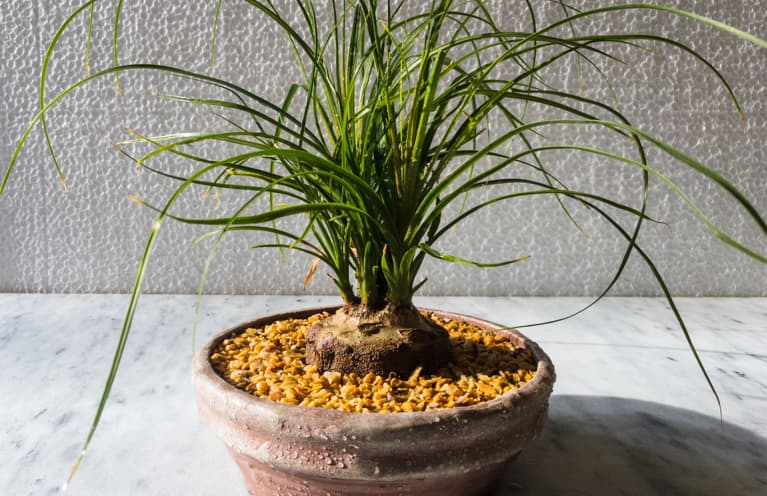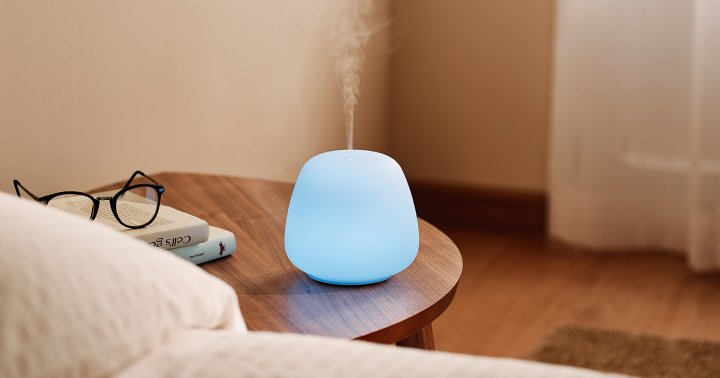Found It: A Striking Houseplant You Won't Have To Worry About On Vacation
This wild-haired succulent makes such a statement.


Our editors have independently chosen the products listed on this page. If you purchase something mentioned in this article, we may earn a small commission.
If successful plant parenthood has seemed elusive, we have your answer! The Ponytail Palm is a plant that does best with little to no attention. You don’t need complicated watering schedules or specially calibrated greenhouses to care for this unique tropical "tree." Just follow these care tips and watch it thrive in your home.
Despite its name and its appearance, the Ponytail Palm (Beaucarnea recurvata) is not a palm tree at all. This lush plant, native to Mexico, with its free-flowing ponytail of leaves, is actually a member of the succulent family. And that’s exactly why it’s known as a low-maintenance houseplant for even the most amateur of green thumbs.
Beatriz Garces of Nature’s Way Farms explains, “The Ponytail Palm is a popular houseplant for its drought-tolerant nature and adaptability to almost any environment. It stores water in its unique trunk, which is why it is so easy to maintain."
While it first became popular in the 1970s, Garces describes the plant’s recent moment in the sun, “We have seen a resurgence in popularity of the Ponytail Palm due to its unique appearance. Its exposed, unique, slender trunk paired with thin, green, curly fronds makes the Ponytail Palm a statement piece on any table.”
Now, you can find Ponytail Palms at most garden stores that sell houseplants. They’ll rarely reach over four feet when grown inside and are simple to keep at a manageable indoor size.
Caring for your Ponytail Palm.
You can enjoy the unique, perky nature of this plant inside your home even if you have a busy schedule. Here's what to know about its water, temperature, sun, and soil needs.
Stuart Mackenzie, a horticulturist at Trees.com, explains, “The Ponytail Palm stores water in its bulbous trunk, so watering is easy.” The plant does best in a desert-like environment, so don’t get overzealous with watering; twice a month should suffice.
As with any plant, do your best to keep to a consistent watering schedule with your Ponytail Palm and dump out any water leftover in its saucer so it's not sitting in moisture.
Have to leave town for a few weeks? No big deal. Your Ponytail Palm will be waiting for you when you get back—and it should be as green as ever. Ayelet Faerman of Verdant Lyfe describes the Ponytail Palm as, “A great starter houseplant and easy to care for with the ability to leave it for vacation or other travel with no worries.” Just give it a thorough watering before you head off, get rid of any standing water, and you'll be good to go.
Since these plants are native to semi-desert areas in Mexico, they thrive in a warm, dry climate and won't do well in below-freezing temperatures. Lindsey Hyland, a gardening expert and founder of Urban Organic Yield, advises keeping your Ponytail Palm in temperatures between 65 and 75 degrees Fahrenheit.
Like many members of the succulent family, Ponytail Palms thrive under bright, indirect light. Garces says, “Placement near a bright window or in a bright room is ideal.” If you live in Zones 9 to 10, she continues, “You can also enjoy your Ponytail Palm as a tabletop plant on any covered patio, porch, or deck.”
Faerman adds that when Ponytail Palms are exposed to brighter light and full sun exposure, there’s an added benefit. The plant will take on some red coloring and add a vibrant pop of crimson color to your home garden.
For a plant that does best when ignored, it’s no surprise that a Ponytail Palm does not like moist, wet soil. Faerman recommends a palm or cactus soil that allows for maximum drainage and will dry out completely between waterings.
Ponytail Palms are slow-growing and they enjoy being tightly bound within a pot or planter. Mackenzie explains, “It’s best to keep the ponytail palm pot bound, and upgrade pots in increments that will keep the roots bound.”
Faerman adds, “I would recommend only repotting it once its roots have maximized the pot.” You’ll know it has reached this point, which may occur biannually, when you push on the outside of the pot and it doesn’t give. Look for a pot that’s no bigger than two inches larger than the bulbous trunk.
Common problems with the Ponytail Palm.
While they’re incredibly easy to care for, there are a few issues that can arise with the Ponytail Palm. But, if you’re aware of them, you can easily get back on track and have your wild-haired succulent looking healthy in no time.
How to grow multiple trunks on a Ponytail Palm.
While propagating a Ponytail Palm is no easy feat, your plant may slowly develop multiple heads, or ‘pups’ along its trunk that will sprout their own ponytails of fronds.
Faerman says, “New growth ‘pups’ can be carefully cut from the trunk, rooted, and will eventually form their own trunk over time.” It is not as simple a process as some other succulents and plants where a simple cutting quickly turns into a new plant, but it is something to look forward to as you take care of your Ponytail Palm over the years.
The beauty of a Ponytail Palm—beyond its streaming green fronds—is the ease in taking care of it. Less is more when it comes to the Ponytail Palm: Less water, less attention, less room in the planter, less frequent repotting, and absolutely no trimming. The only thing you’ll want more of is sunlight. This is the ultimate low-maintenance entry into plant parenthood to prove to yourself that yes, you have a green thumb too!
Want to learn how feng shui can help you create a high-vibe home and set powerful intentions to manifest your dreams? This is feng shui the modern way - no superstitions, all good vibes. Click here to register for a free session with Dana that will give you 3 tips to transform your home today!
Reset Your Gut
Sign up for our FREE doctor-approved gut health guide featuring shopping lists, recipes, and tips
You are now subscribed
Be on the lookout for a welcome email in your inbox!
https://www.mindbodygreen.com/articles/ponytail-palm

 AbJimroe
AbJimroe 































